COSAM News Articles 2020 June Lin Receives NSF Grant to Research Mathematical Studies of Plasmonic Nanohole Resonances
Lin Receives NSF Grant to Research Mathematical Studies of Plasmonic Nanohole Resonances
Junshan Lin, an associate professor in the Department of Mathematics and Statistics, is the recipient of a National Science Foundation award for $221,487 to research mathematical studies of plasmonic nanohole resonances. The research proposal is titled Imaging and Sensing via Plasmonic Nanohole Resonances: Quantitative Analysis and Numerical Inversion and runs from September 2020 through August 2023.
Lin is the principal investigator and his research will be conducted at Auburn University to address key scientific challenges in the mathematical investigation of plasmonic resonances and their applications in imaging and sensing. He will be seeking to find mathematic and computational solutions to improve biochemical sensors and imaging techniques, which rely upon plasmonic hole resonances.
“Surface plasmonic resonances refer to collective oscillations in the electron density at the surface of a metal and can be induced by the optical resonance of metals,” he said. “The plasmonic resonances with nanoholes can induce so-called extraordinary optical transmission and strong optical field confinement. Such unusual phenomena opened up new possibilities for modern science and technology, especially in biology and medicine.”
His research could impact future biochemical sensing and imaging technologies that rely on high-quality sensors to detect biomolecular events and high-resolution microscopies to image biomolecules.
“The capability to trigger extraordinary optical transmission and to confine strong optical field in plasmonic subwavelength structure has already found novel applications in biological and chemical sensing, optical lenses, and other novel optical devices. The problems studied in this project are related to their applications in bio-sensing and super-resolution imaging,” Lin said.
Extraordinary optical transmissions were discovered in 1998 and occur when a metallic film has a numerically designed repeating pattern which light is beamed through subwavelength apertures.
“Mathematically, the project addresses new types of mathematical problems in inverse problems and imaging,” he said. “Beyond that, the results of the proposed work are expected to provide physical experimentalists with essential mathematical tools to improve the performance and functionalities of nano-plasmonic sensors, and provide new avenues for super-resolution imaging.”
Lin will be using an array of mathematical tools to conduct his research.
“Mathematical analysis tools based upon a combination of boundary integral equations, asymptotic analysis, and the Gohberg-Sigal theory will be developed for characterization of spectral sensitivity when plasmonic nanoholes are used in biochemical sensing,” Lin explained. “In addition, in order to accelerate the solution of related inverse spectral problems, efficient finite element-boundary integral equation eigensolvers will be designed to address the significant computational challenges brought forth by the multiscale nature of the underlying problems. Finally, motivated by the studies of plasmonic nanohole resonances, I will propose a new super-resolution imaging modality by using illumination pattern generated from a collection of subwavelength hole resonantors. In this regard, I will investigate the mathematical modeling, and develop deconvolution and optimization type numerical approaches for the corresponding inverse problems.”
Through this NSF grant, Lin hopes to be able to develop the numerical basis to improve the sensing and imaging process.
“The objective of the project is to develop analytical and computational techniques that will allow for characterization of spectral sensitivity and non-destructive detection of bio-samples when plasmonic resonances are used in biochemical sensing, and to provide the mathematical foundation and inversion algorithms for the proposed super-resolution imaging technique,” he said.
Latest Headlines
-
07/09/2024
-
Summer Bridge Program celebrates 21 incoming Auburn students as they prepare for future STEM careers07/02/2024
-
07/02/2024
-
06/17/2024
-
06/07/2024

